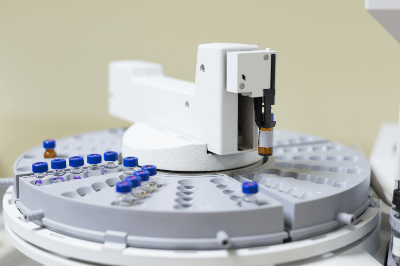What Is an Autosampler?

An Autosampler is an automated sample preparation device.
When an analyzer is used to perform some type of analysis, it is common for the sample to be introduced manually. By using an Autosampler, the sample can be automatically supplied and analyzed.
Basically, they are used in combination with analyzers such as elemental analyzers and chromatography. Various types of Autosamplers have been developed to match the introduction system of analyzers, such as for solid samples and liquid samples.
Uses of Autosamplers
Autosamplers are used in a variety of industrial fields. Typical applications include chromatography, environmental analysis, and the pharmaceutical and food industries.
They are used to automatically inject samples in analyses such as liquid chromatography (LC) and gas chromatography (GC). Autosamplers allow for more accurate and faster analysis than manual injection of samples.
In environmental analysis, it is used to measure the concentration of contaminants in water or air. Because of its ability to continuously measure at regular intervals, it is an indispensable instrument in continuous control plants for process systems.
It is also widely used in the food industry and the pharmaceutical field. In the medical field, they are used for testing blood and urine, efficiently processing a large number of samples. In the pharmaceutical field, autosamplers are used to analyze ingredients of raw materials and products, and are valued as a means of high-precision, high-volume analysis.
Principle of Autosampler
Autosamplers are available in a wide variety of types and applications, each with different principles.
When analyzing with an autosampler, the first step is to prepare the sample. The sample to be injected is placed in a sample dish, microplate, or other sample containers in advance, and the injection volume and number of injections are set according to the sample volume and concentration. Many Autosamplers are designed to perform sample preparation automatically.
After sample preparation is complete, the sample in the sample container is set in the Autosampler and automatically fed. Some autosamplers may also have functions to automatically mix the sample and control the temperature.
Once the sample is supplied, the analyzer automatically performs the analysis. The analysis results are processed by the autosampler and may be sent to a PC or data acquisition device.
Types of Autosamplers
There are various types of autosamplers, depending on the type of analyzer and sample used. The following are some of the types of autosamplers:
1. Random Access Type
This type of autosampler can randomly supply various types of samples. It is used to process a large volume of samples and can do so with high efficiency. It is characterized by its high analytical versatility.
2. Front Access Type
The front-access type is an autosampler in which the sample is manually loaded from the front panel. Since the sample is not automatically supplied, the user must take the time to set and remove the sample. However, the instrument is easy to handle and sample setting is easier than with manual samplers.
Front-access models require manual setting and are used to process small sample volumes. It is suitable for the use of expensive reagents and for the analysis of trace samples. Due to their characteristics, these products are used in the research and development field.
3. Carry-Fill Type
This type of autosampler supplies samples by automatically aspirating samples. It is used in liquid chromatography, for example, when there is a suitable sample in the aspiration section.
In dye analysis and fluorescence spectrum analysis, it is used to achieve accurate sample supply. It is also used in cell culture analysis to automate sample delivery.
4. Microplates
An autosampler that uses microplates to process multiple samples at once. They are used for analyses that require high throughput rates.